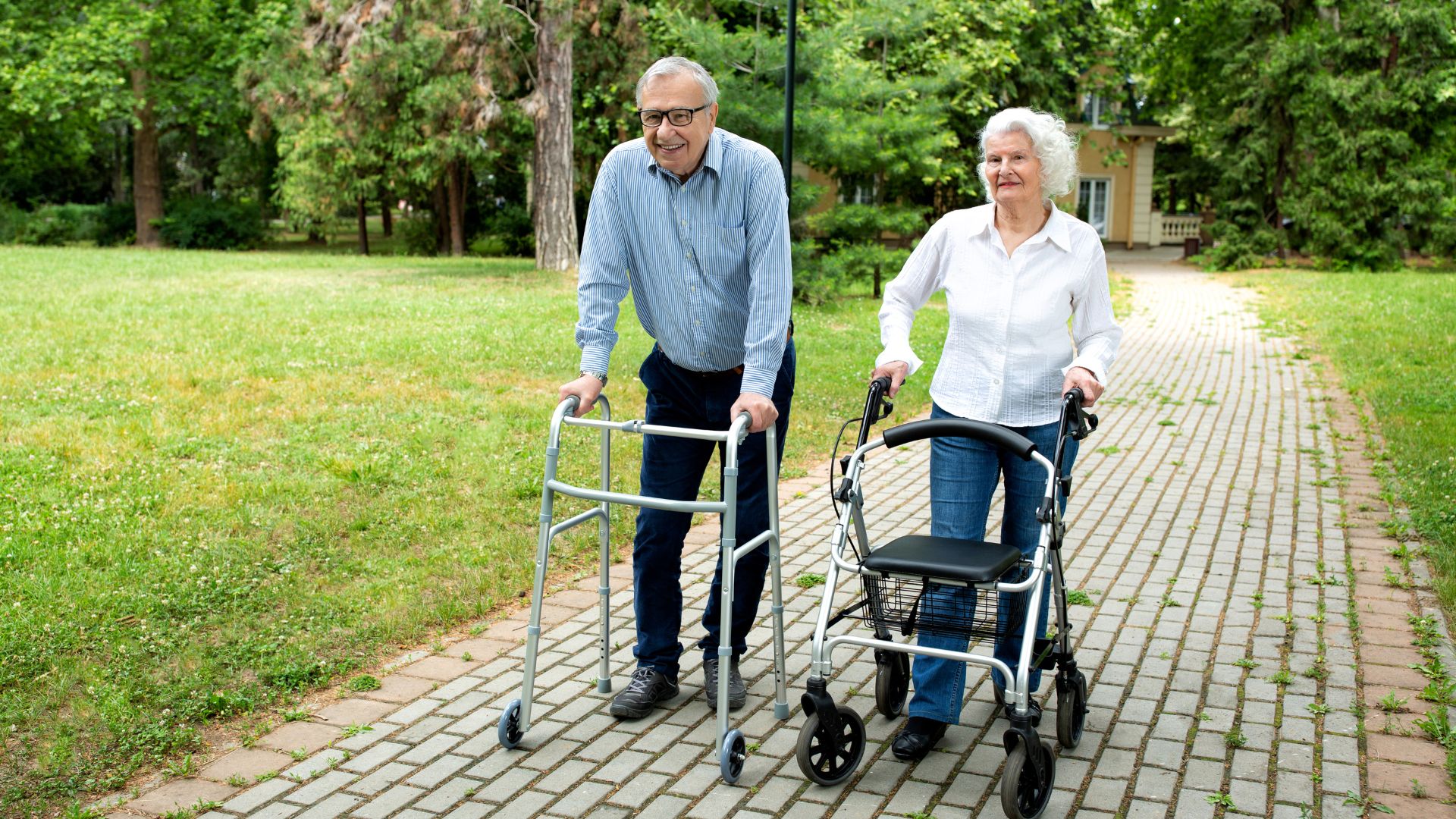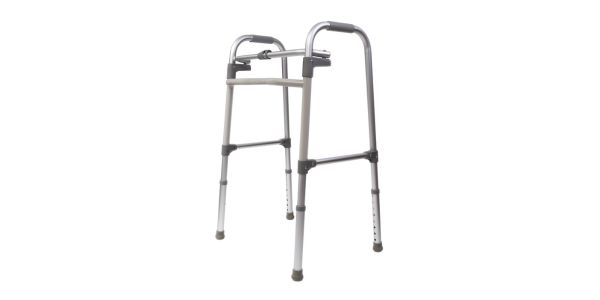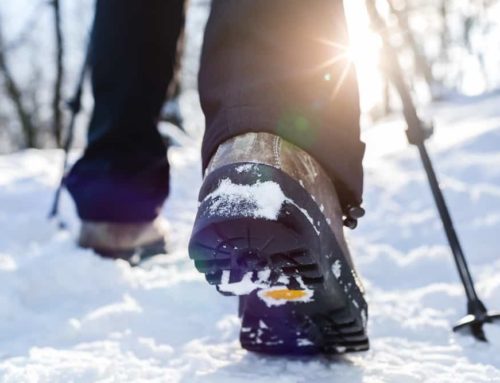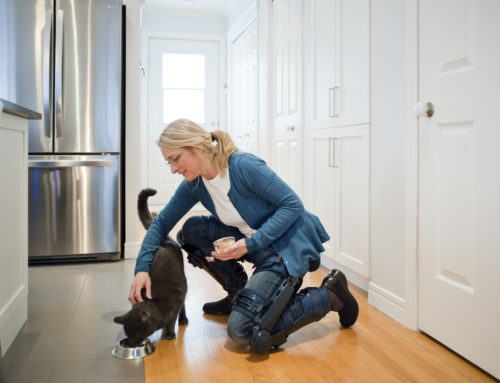Walking aids can assist people experiencing injury, weakness or imbalance in standing and walking. There are many different types of walking aids that fall into several categories. A physiotherapist or other healthcare provider can help choose the right walking aid for you based on your individual needs.
In addition, physiotherapists can also progress or graduate a person from a walking aid, to promote physical independence from the walking aid. In this article, we look at the various forms of walking aids and how to choose and measure for the right walking aid.
Table of Contents
- What is a walking aid?
- Different forms walking aids
- How to choose the right walking aid
- How physiotherapists can help with proper walking aid usage
- Conclusion
What is a Walking Aid?
A walking aid is an external device, usually a hand-held piece of equipment, that a person uses to assist in walking, standing, and keeping their balance and base of support while doing activities.
Physiotherapists often prescribe walking aids or walking assistive devices to clients who require support, additional balance, and security when walking or standing. Sometimes, walking aids are prescribed when a person is recovering from surgery.
For example, a surgeon may have instructed their patient to have limited weight bearing on their ankle or foot. In this case, they would suggest a walking aid, like crutches, to relieve that weight when standing or walking. In other cases, a person may experience weakness or feel imbalanced, thus requiring assistance from a walking aid to improve their base of support.
These assistive devices often improve a person’s independence and function throughout their lives.
Different Forms of Walking Aids
Walking aids fall into multiple categories and can include any of the following:
1. Crutches
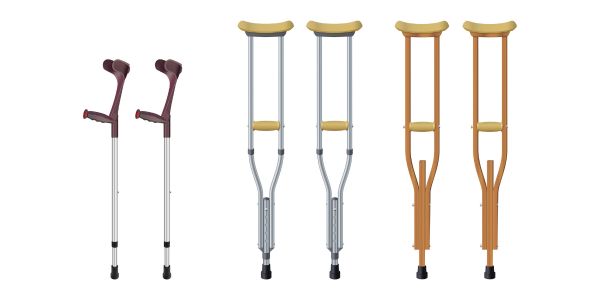 Prescribed due to acute lower extremity injuries like ankle sprains or twisted knees. In addition to having them available in hospitals for people coming in with injuries, it makes sense to have them on hand while playing sports like soccer, football, tennis, hockey, or any activity where injuries to the lower limb are common.
Prescribed due to acute lower extremity injuries like ankle sprains or twisted knees. In addition to having them available in hospitals for people coming in with injuries, it makes sense to have them on hand while playing sports like soccer, football, tennis, hockey, or any activity where injuries to the lower limb are common.
Often made from aluminum with a wide degree of freedom for adjustability, crutches can be useful for people that need to abide by weight bearing precautions or restrictions.
For instance, if a person is coming off of ankle surgery and the surgeon is recommending one week of non weight bearing, these crutches can help this person achieve non weight bearing status but also be mobile enough to engage in day-to-day activities.
2. Canes
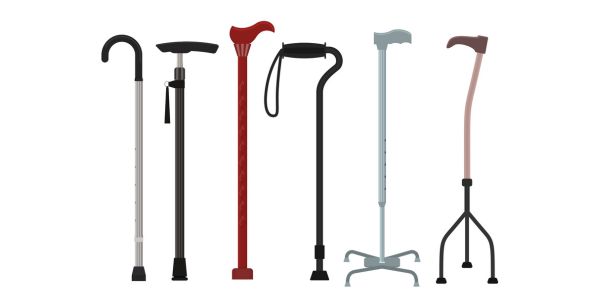 Single point canes are the most common form of walking aid for older populations. Some people may not know however that canes come with a variety of handles, bases (e.g., like quad-canes, wider bases, ice picks), adaptations (e.g., collapsible, ergonomic handles) to suit the client’s needs.
Single point canes are the most common form of walking aid for older populations. Some people may not know however that canes come with a variety of handles, bases (e.g., like quad-canes, wider bases, ice picks), adaptations (e.g., collapsible, ergonomic handles) to suit the client’s needs.
3. Walkers
There are many types of walkers such as standard walkers, two wheeled walkers, four wheeled walkers, high-wheeled walker, and variations of bases for these walkers. The person’s upper body strength, pattern of gait and neurological competency will dictate the type of walking aid they should use.
For instance, a person living with advanced stages of Parkinson’s disease may require a two-wheeled walker with sleds to ensure that the walking aid does not roll away from them inappropriately.
4. Rollators
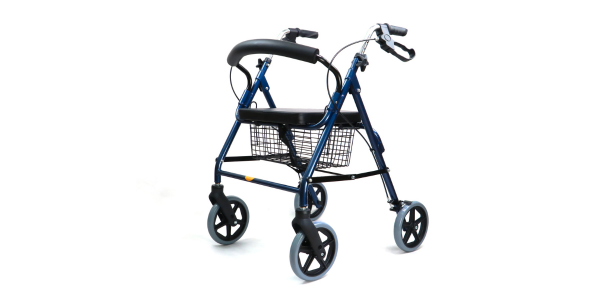 A rollator is a four-wheeled walker with brakes and a seat attached to the structure of the walking aid. Rollators allow for indoor and outdoor walking.
A rollator is a four-wheeled walker with brakes and a seat attached to the structure of the walking aid. Rollators allow for indoor and outdoor walking.
Rollators are often prescribed for clients whose walking has even and equal step lengths and can take independent steps but are looking for additional balance and assurance. From a practical standpoint, many rollators have basket attachments that allow the client to carry meaningful items (e.g., light groceries, a purse).
5. Foot Up or Ankle-Foot Orthoses
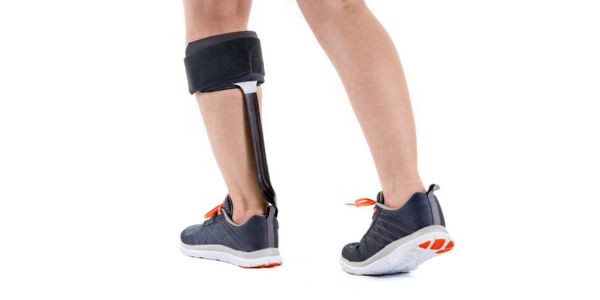 A more concealed type of walking aid is something called an ankle-foot orthosis. The primary goal for this orthosis is to focus on the ankle and foot providing a form of support to clear the foot and heal during the swing phase of gait into approve a person’s ability to strike the ground with their heel.
A more concealed type of walking aid is something called an ankle-foot orthosis. The primary goal for this orthosis is to focus on the ankle and foot providing a form of support to clear the foot and heal during the swing phase of gait into approve a person’s ability to strike the ground with their heel.
Ankle-foot orthoses are usually created by a certified orthotist in their custom to the individual. Some forms of off the shelf orthoses can be attached to a person’s ankle in the shoe; this device would act on the person’s ankle and foot by pulling the foot upwards so that they can clear the floor and ground when swinging their foot through the air. These types of products are effective for people who suffer from foot-drop (e.g., peripheral nerve injuries, post-stroke, post TBI).
Some ankle foot orthoses fit over the shoe and can still help to lift up the person’s ankle so their foot can clear the ground when walking. This prevents toe dragging and possible tripping. Although they are not necessarily custom, many people who use these devices (like the Xtern Turbo med) find it more adaptable to different shoes/situations and easier to adhere to.
6. Walking Poles
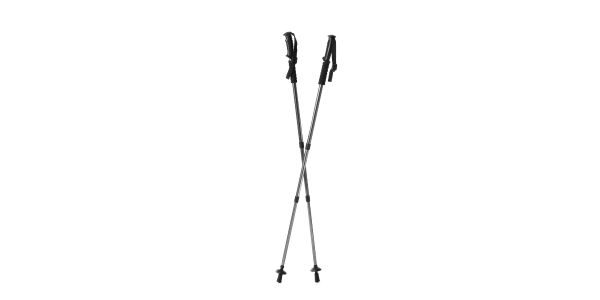 Also called Nordic poles, walking poles have been used with higher functioning and higher-level athletes looking to improve cardiovascular and cardiorespiratory fitness while hiking or traversing new environments.
Also called Nordic poles, walking poles have been used with higher functioning and higher-level athletes looking to improve cardiovascular and cardiorespiratory fitness while hiking or traversing new environments.
Physiotherapists have used newer poles to assist in improving reciprocal gait, arm swing, step length, step speed, and uniformity when retraining a person’s walking pattern. Typically, walking poles would be recommended for someone with a higher level of balance who is looking to walking the community.
How to Choose the Right Walking Aid
In order to determine which walking aid is right for you, your therapists will assess your ability to walk, overall strength, independence, and balance before prescribing the appropriate device. They will take into consideration cognitive ability, ability to follow instructions, supervision, safety, and your goals.
There are some walking aids that would not be appropriate for certain populations. For instance, a person who is not able to walk with one foot in front of the other (reciprocal) will most likely not be using Nordic poles to ambulate, or traverse across uneven grounds.
Measuring for a walking aid requires the clinician to take a variety of factors into consideration. The client’s height and arm length often determine what size a walking aid needs to be. For instance, when measuring a person for a cane the physiotherapist will be looking for the cane handle to be approximately at the wrist crease when the arm is relaxed by the side of the person’s body. The same applies for crutches, walkers, and rollator.
In addition, many rollators and walkers are sized for specific heights which gives them correct proportions for handle height and wheel bases. For walking poles, generally the handles should be at the same height as the persons elbow at 90 degrees, which is approximately the mid-abdomen/lower chest area.
How Physiotherapists Can Help with Proper Walking Aid Usage
Although the purpose of these assistive devices is to facilitate walking, it is important to remember that walking aid the upper extremities and the trunk are highly involved in using them. Your physiotherapist can help make sure that the wrist, elbows, shoulders, and trunk are in an appropriate ergonomic, supportive position so that it helps create efficient and independent walking and provides the support to your walking needs.
A quick tip I like to give clients using crutches or canes is to really look at how their hands and wrists are positioned relative to their elbows. If their wrists are in a lot of extension (bending backwards) and their elbows are also locked out in extension (straight) then that means the cane needs to be adjusted a little bit higher. Clients may also need education on using a more active grip, to bring their wrists into a neutral position.
In addition, your physiotherapist can ensure that you are not changing your movement patterns while using your walking aid in a way that will negatively impact your long-term mobility. In essence, the number of repetitions completed, whether they be proper or improper form, adds to the permanency of a person’s quality of walking.
Spending time with your physiotherapist to adjust and address your walking aid means a greater chance that you will use it properly and have a higher potential of progressing to the next steps. In many cases, the goal is to not use a walking aid at all and to eventually walk without assistance.
Conclusion
In general, gait aids that offer improved mobility, speed and transferability to various environments are often less stable and require the client to have a higher level of balance, strength, and starting mobility.
A walking aid needs to be properly prescribed, dispensed, used and progressed as appropriate. The therapists at Propel Physiotherapy are highly trained to address your walking aid needs and to think about the short-term, medium-term, and long-term progressions for your lifestyle.
Still have questions? Call us to find out more!
Written by

